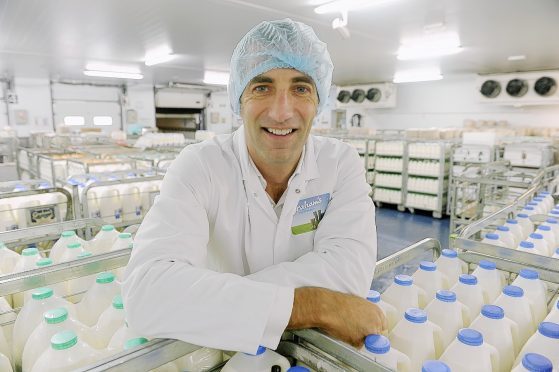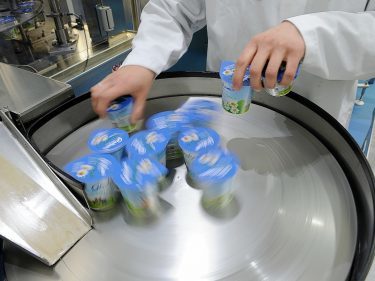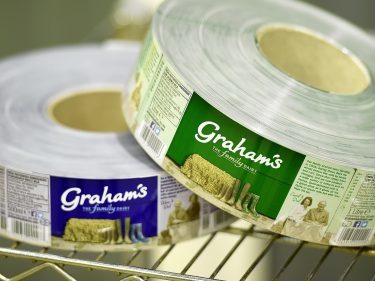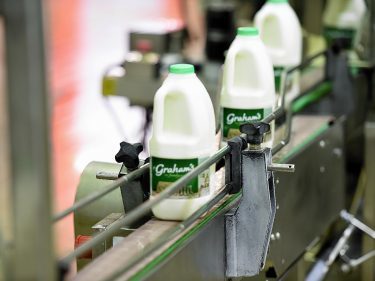Scotland, and the UK, are often viewed as behind the curve when it comes to milk processing and the ability to add value to raw milk.
For years milk processors focused on chasing liquid milk contracts with major supermarkets chains, with little attention given to producing products such as yoghurt, butter and skimmed milk powder on home soils.
However, Robert Graham, of Graham’s The Family Dairy, claims his company is doing the exact opposite.
While walking around the company’s factory in Nairn, which recently received a cash injection in excess of £1million to create a new yoghurt-making facility, he said the Scottish dairy sector has had very little new product development in the past few years apart from that done by Graham’s.
Although liquid milk sales make up the bulk of the company’s turnover, it has expanded its offering to include butter, cheese, cream, ice-cream, yoghurt, sour cream, cottage cheese and quark.
It has also landed contracts supplying major retailers and coffee shop chains including Aldi and Starbucks.
The company, which employs just over 600 people, has its main site at Bridge of Allan and another site at Glenfield in Fife.
As well as its three production sites, the company has four distribution sites, in Inverurie, Brechin, Fife and Glasgow.
It took on the Nairn factory in 2010 and since then the company has gone about improving the facility and most recently installing the yoghurt-making kit.
According to Mr Graham, the company is currently buying around 15% of all the liquid milk produced in Scotland from its pool of 100 dedicated farmer suppliers.
“There’s three dairies north of the M8 of any substantial size and they are all ours. We have got three good sites that make good products,” said Mr Graham, whose grandfather Robert started the business in 1939.
He admits the company needs to generate more business for the Nairn factory, which processes bottled milk and yoghurts from milk sourced from five farmers, but says he is confident he can achieve this.
“We also need to do more around growing our yoghurt business, growing our listings and doing more on new product development,” said Mr Graham.
He said he is awaiting news from government over the company’s plans to build a new housing development and a new £20million dairy facility on the outskirts of Stirling.
The plans, which were rejected by councillors, are on appeal to government ministers.
This could be a real game-changer for the company as the funds raised from the housing development will be invested into the dairy production facilities.
“It was (the plans) going to allow us to build a new dairy next to the market in Stirling,” said Mr Graham.
“It was about annual investment across all of our sites. At Nairn it could have meant investing in more capacity. It was about taking a step change in new product development and marketing so we can compete against some of the big guys.”
He said if the plans were rejected it would be “pretty disappointing for the Scottish dairy industry” which has had very little investment in production capacity in recent years.
So what could this new £20million dairy look like?
“The Bridge of Allan site would move over to just doing butter production,” said Mr Graham.
“The plan for the new site is to produce liquid milk, cheddar and another product category which would be around some ideas we have on new product development.”
Yoghurt and liquid milk for the north region would continue to be produced in Nairn, while the Glenfield site would produce cottage cheese and quark.
Regardless of whether the new dairy development goes ahead, Mr Graham said his mission remains unchanged – to get more Scottish shoppers buying home-produced dairy produce instead of imported products.
In particular, he wants his company to be producing the number one butter brand in Scotland – at present £50million worth of imported butter is brought into the country every year and the number one brand is a Danish product.
Mr Graham said: “Butter for us last year grew it’s share by 30% and both the block and spreadable (butters) are key markets for us particularly when so much product is coming in from outside of Scotland and the UK.”
He applauded the Scottish Government’s new dairy brand which aims to get more Scottish dairy produce exported around the world, but said making wins at home was his priority.
That said, the company does export some of its products to markets including Ireland, Denmark, France, Spain, Malta, Lebanon and the United Arab Emirates.
In response to recent criticism among some dairy farmers that the company has not been fair to its producers, Mr Graham said: “We are doing more than our bit.”
He said the recently introduced AB pricing mechanism, although not popular when it launched, was achieving what it had set out to do.
The mechanism pays farmers two prices – an A price for 80% of the milk volume they produced the year before and a B price for anything on top of this.
The A price currently stands at 20.5p a litre, while the B price is 14p a litre.
Mr Graham said: “AB pricing has a role. We don’t have 20 litres coming in at the B price out of every 100 litres. We maybe have 12 coming in at the B price. People have brought their product back and that has helped our business being more in balance.”
At the time the pricing mechanism was introduced, the company’s chairman, Robert Graham sen, said the firm was having to process an extra 1.3million litres of milk a month.
This was being sold at a loss of between 5 and 7p a litre or £65,000 and £91,000 a month. The new pricing was launched to discourage farmers from producing too much milk.
Lastly, on the issue of potential farmer gagging – it is reported that Graham’s suppliers are not allowed to speak to members of the press – Mr Graham said this was normal business practice as the relationship between a farmer and his milk buyer was confidential.
He dismissed any criticism from farmers against the business and said Graham’s had a good track record of looking after its farmer suppliers.
“Almost every month since de-regulation for over 20 years our price has been right at the top,” said Mr Graham.



